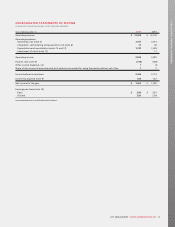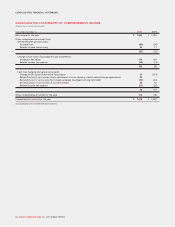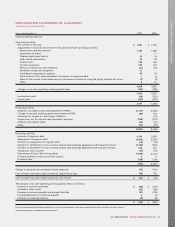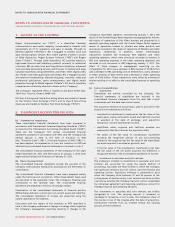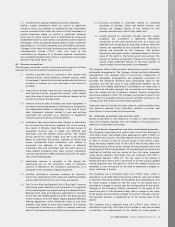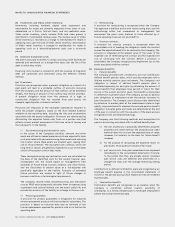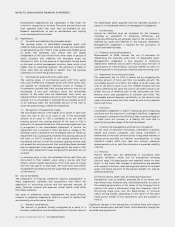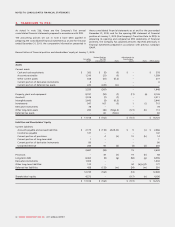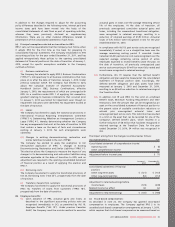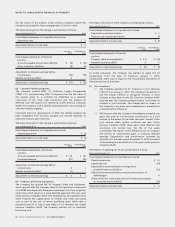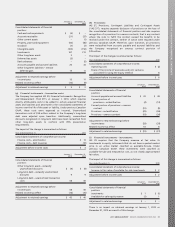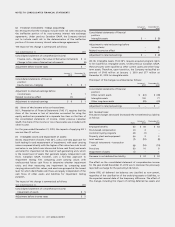Rogers 2011 Annual Report Download - page 92
Download and view the complete annual report
Please find page 92 of the 2011 Rogers annual report below. You can navigate through the pages in the report by either clicking on the pages listed below, or by using the keyword search tool below to find specific information within the annual report.
NOTES TO CONSOLIDATED FINANCIAL STATEMENTS
(k) Inventories and Video rental inventory:
Inventories, including handsets, digital cable equipment and
merchandise for resale, are primarily measured at the lower of cost,
determined on a first-in, first-out basis, and net realizable value.
Video rental inventory, which includes DVDs and video games, is
amortized to its estimated residual value. The residual value of Video
rental inventory is recorded as a charge to merchandise for resale in
operating costs upon the sale of Video rental inventory. Amortization
of Video rental inventory is charged to merchandise for resale in
operating costs on a diminishing-balance basis over a six-month
period.
(l) Deferred transaction costs:
The direct costs paid to lenders to obtain revolving credit facilities are
deferred and amortized on a straight-line basis over the life of the
debt to which they relate.
Financing costs incurred in connection with the issuance of long-term
debt are capitalized and amortized using the effective interest
method.
(m) Provisions:
Provisions are recognized when a present obligation as a result of a
past event will lead to a probable outflow of economic resources
from the Company and the amount of that outflow can be estimated
reliably. The timing or amount of the outflow may still be uncertain.
A present obligation arises from the presence of a legal or
constructive obligation that has resulted from past events, for
example, legal disputes or onerous contracts.
Provisions are measured at the estimated expenditure required to
settle the present obligation, based on the most reliable evidence
available at the reporting date, including the risks and uncertainties
associated with the present obligation. Provisions are determined by
discounting the expected future cash flows at a pre-tax rate that
reflects current market assessments of the time value of money and
the risks specific to the liability.
(i) Decommissioning and restoration costs:
In the course of the Company’s activities, network and other
assets are utilized on leased premises which are expected to have
costs associated with decommissioning these assets and restoring
the location where these assets are situated upon ceasing their
use on those premises. The associated cash outflows, which are
long-term in nature, are generally expected to occur at the dates
of exit of the assets to which they relate.
These decommissioning and restoration costs are calculated on
the basis of the identified costs for the current financial year,
extrapolated into the future based on management’s best
estimates of future trends in prices, inflation, and other factors,
and are discounted to present value at a risk-adjusted rate
specifically applicable to the liability. Forecasts of estimated
future provisions are revised in light of future changes in
business conditions or technological requirements.
The Company records these decommissioning and restoration
costs as PP&E and subsequently allocates them to expense using
a systematic and rational method over the asset’s useful life, and
records the accretion of the liability as a charge to finance costs.
(ii) Product guarantees:
A provision for product guarantees is recognized for instances
where replacement products will be provided to subscribers. The
provision is based on historical data and an estimate of the
future replacements required for products sold on or before the
reporting date.
(iii) Restructuring:
A provision for restructuring is recognized when the Company
has approved a detailed and formal restructuring plan, and the
restructuring either has commenced or management has
announced the plan’s main features to those affected by it.
Future operating losses are not provided for.
(iv) Onerous contracts:
A provision for onerous contracts is recognized when the
unavoidable costs of meeting the obligation under the contract
exceed the expected benefits to be derived by the Company. The
provision is measured at the present value of the lower of the
expected cost of terminating the contract and the expected net
cost of continuing with the contract. Before a provision is
established, the Company recognizes any impairment loss on the
assets associated with the contract.
(n) Employee benefits:
(i) Pension benefits:
The Company provides both contributory and non-contributory
defined benefit pension plans, which provide employees with a
lifetime monthly pension upon retirement. The Company’s net
obligation in respect of defined benefit pension plans is
calculated separately for each plan by estimating the amount of
future benefits that employees have earned in return for their
service in the current and prior years; that benefit is discounted
to determine its present value. The Company accrues its pension
plan obligations as employees render the services necessary to
earn the pension. The Company uses a discount rate determined
by reference to market yields at the measurement date on high
quality corporate bonds to measure the accrued pension benefit
obligation. Actuarial gains and losses are determined at the end
of the year in connection with the valuation of the plans and are
recognized in OCI and retained earnings.
The Company uses the following methods and assumptions for
pension accounting associated with its defined benefit plans:
(a) the cost of pensions is actuarially determined using the
projected unit credit method. The projected unit credit
method takes into account the expected rates of salary
increases, for instance, as the basis for future benefit
increases.
(b) for the purpose of calculating the expected return on
plan assets, those assets are valued at fair value.
(c) past service costs from plan amendments are expensed
immediately in the consolidated statements of income
to the extent that they are already vested. Unvested
past service costs are deferred and amortized on a
straight-line basis over the average remaining vesting
period.
Contributions to defined contribution plans are recognized as an
employee benefit expense in the consolidated statements of
income in the periods during which related services are rendered
by employees.
(ii) Termination benefits:
Termination benefits are recognized as an expense when the
Company is committed without realistic possibility of
withdrawal, to a formal detailed plan to terminate employment
before the normal retirement date.
88 ROGERS COMMUNICATIONS INC. 2011 ANNUAL REPORT



